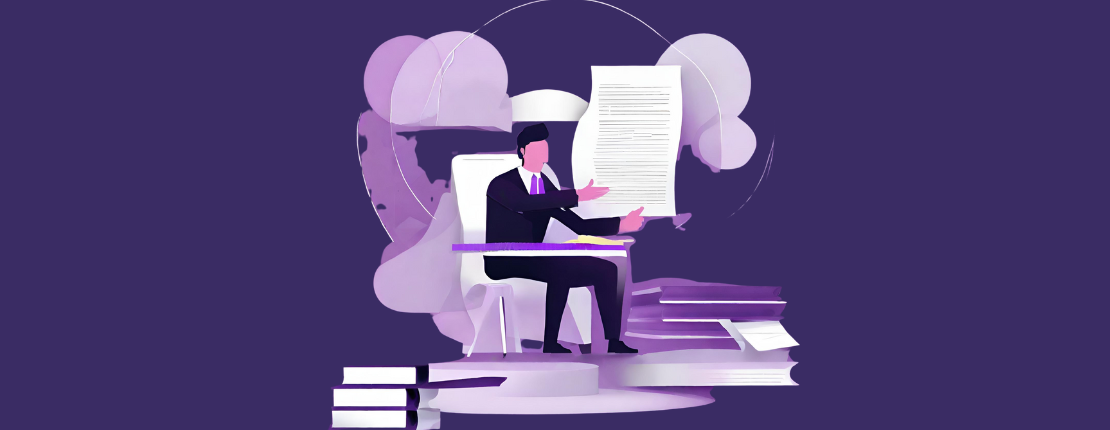Why do contract management solutions exist?
Things were going fine between legal and sales. But they are getting out of hand lately. Sales needs to catch up on renewals big time. A recent auto-renewal threw you off. No one knows what’s happening anymore. The legal team has been called a black hole. The churn rate is off the charts. That deal you closed is nagging at your insides. It could have been negotiated better after the sleepless nights you spent on the proposal. The other soft yeses are still going to go back and forth for the next three months before you shake hands on them. Maybe five. Is there even a contract management solution in place? When did hope become a strategy? If this is even remotely true, stop what you’re doing and grab a chair. If there’s something more urgent, go on. This guide isn’t going to give you a quick fix. Depending on which part of your contracting process is going poorly, sales, HR, finance, and procurement are frustrated, and you’re probably experiencing overload, exhaustion, and chaos. If you’re still reading, you know it pays to think big-picture. Reasons why contract management solutions even exist:- 60–80% of B2B deals are managed by contracts (Gartner)
- The average business maintains 20,000–40,000 contracts (PwC)
- Ineffective contract management costs businesses up to 9.2% of annual revenue (Tim Cummins, CEO of IACCM)
- 12–15% of all contracts are lost
Who needs one?
Regardless of industry or scale, all businesses run on contracts. The main objective of contract management is to streamline a process so businesses can stay on top of their contracts to utilize their fullest value, improve contract performance, meet obligations, and reduce risks and operational and maverick costs. A good contract management solution that works for you is crafted to improve revenues, productivity, and compliance. With smart features and functionalities throughout the contract lifecycle, CLM platforms align legal operations to business goals while helping stakeholder contracting processes stay agile in an uncertain business climate, and realize greater opportunities for revenue growth.Pop quiz: When should legal get involved in the CLM process? Legal influences almost every phase of CLM either directly or indirectly. However hands-on involvement happens only in the negotiation phase. With necessary planning and operational systems, the business can be empowered with guardrails to preserve legal strategic resources.
Problems with the traditional CLM platforms
With CLMs, the obvious choice could often be a misfit. Many enterprise-grade CLMs may have been practical when they hit the market in the early 2000s and 2010s. Most contract management solutions were document management systems of record. Besides, this software tended to be hosted on-premise during this time, customers expected to spend months implementing and configuring enterprise software systems. But that was a long time ago. Today, most CLM applications have transitioned from sales tools for businesses of all sizes to offering more customized software solutions. Players like HyperStart have far outperformed the other competitors in the market regarding features.Is your organization ready for contract management solutions?
“The discovery process is internal.” Put purpose at the core of your strategy, HBR
Your CLM software should help you maintain quick contract turnaround with simplified daily operations. This impacts revenues, negotiation cycles, and deal closures directly. But finding the right fit means more than browsing through the most popular picks on the market or going with the CLM you’ve used in a previous organization. As you begin discussing new solutions internally or exploring top solution providers, consider the following:Your business goals:
- What north-star goals have you set for your business, and what KPIs are you using to measure your progress?
- How are contracts created, negotiated, stored, tracked, and signed in your organization?
- Do you find scope creep, hidden fees, missed renewals, revenue, and legal risks? Stakeholder needs:
- Are your legal, sales, finance, and procurement teams always fighting fire in contract management?
How simple is:
- Storage & centralization: Is there a central system to store, organize, and access your legacy and digital contracts today? Can you retrieve contract data easily?
- Tracking & analytics: How do you track renewals, obligations, and deadlines?
- Approval workflows: How satisfied are you with the contract approval process in the company?
- Negotiation: How are contract terms negotiated and how long do they take?
- Signing: What is the signing process you follow, and on which tool?
If you could solve only one or two things in the contracting process, what would those be and why?
Partner expectations:
- What percentages of papers are your own and the counterparties’?
- Are you able to tap into valuable vendor-partner-client contract data?
- How confident are you that the company handles compliance well and has minimal risk exposure?
Myth: You should be worried that minimal legal involvement will jeopardize relationships and business. Fact: The value of the legal team is defined by the complexity of the problems it resolves. Namely, challenging negotiations. creativity, and deep analysis. Your precious legal resources are better employed outside of high-volume, low-complexity contracts. Business relationships must be secure enough without legal having to review every SOW, NDA, PO, or MSA. If the relationship is at stake at every turn, a deeper problem of trust needs to be addressed.
Buyer’s guide to contract management solutions
Each business has unique operations, and your chosen contract management solutions must align with your specific processes as closely as possible. There are proven methods to make sure you are thoroughly equipped to navigate the buying process and discover a solution that satisfies both your business and partners with both short-term simplified operations and long-term competitive intelligence.Step 1: Find your ‘why’
Consult with stakeholders and key users to understand what each team requires from a new contract management solutions. For the solution to truly deliver results that align with each team’s unique needs, you’re going to have to get on the drawing board to map out current processes. Engage with individuals who interact with high-volume contracts regularly to get the essence of your teams’ needs. While stakeholder input is valuable, it is also crucial to connect with the users who rely on the system’s functionalities:- Teams responsible for managing contract operations like sales and legal
- Teams heavily dependent on contract data, obligations, renewals, and other features of the CLM like finance, procurement, and counterparty teams
Step 2: Identify your goals
Now that you have considered everyone’s input, it is time to clearly define the objectives and results you want your new CLM to achieve. Create a comprehensive list of qualitative and quantitative KPIs that consider the needs of individual users and the overall business goals. To identify these goals, ask questions like:- Are we considering implementing a CLM for the first time or transitioning from a current system?
- What objectives are we striving to achieve, and how can we effectively track progress?
- Could contract performance management and reporting processes be improved in any areas?
- Are there any challenges and problems we want to address that currently lack the necessary features and capabilities?
- How much time do you have to implement a new contract repository?
- Consider what types of reports and valuable insights are essential for buy-ins.
- Unified repository
- Workflow automation
- Contract monitoring
- Compliance & security
- Contract adaptability
- Implementation & support
- Standardization
- Contract creation & drafting
Step 3: Assess your tech stack
For long-term ease of use and compatibility with a new contract management solutions, consider how potential options align with your existing tech stack. Many CLM platforms may also replace or emulate specific tools that make old systems obsolete, guarantee smoother operations, and save potential costs.Pro Tip: Proactively assess and address any potential integration or compatibility issues. Get a comprehensive mitigation strategy from this stage to the demos and up until the PoC stage. By doing so you can avoid unforeseen costs and surprises that may arise when you commit to your new contract management solutions.It is beneficial to have a unified system and process for improved processes and cross-team alignment. Evaluate the current tech stack to see where else CLM can step in with relevant integrations. Here are a few examples:
- CRM & Sales: Salesforce, Zoho, Hubspot, FreshSales, Greenhouse, Lever
- Storage: Google Drive, Box, and Dropbox
- Signing: DocuSign, Adobe Sign, and Hello Sign
- Workflow management: Jira
- Collaboration: Slack, Teams, and Gmail
Step 4: Compare critical features and capabilities
It’s time to delve into specific features and capabilities a powerful system of intelligence (CLM) should provide. While your prioritization will be based on the goals you identified in step two, there are specific features and functions CLM platforms market that reflect their unique capabilities that can add value to your specific use cases.The contract management solutions checklist
Contract creation- Templatize contracts safely
- Dynamic data tagging
- Rich-text contract editor
- Pre-approved automated contract templates
- Clause library
Replaces: Word, G-docs, PDFApproval workflows
- No-code workflows
- Configure approval waterfalls with conditional logic
- Track pre-execution activity
- Approval workflows
- Split internal and external versions & comments
- Detailed audit trails for contracts
Replaces: Word, Google Docs, EmailNegotiation
- Assign stakeholders, user roles & access control
- Browser-based redlining & review
- Automated version control
- Detailed contract audit trails
Replaces: Word, Google Forms, manual change tracking & version controlSignatures
- Central audit log
- Top security & compliance
- Advanced eSignatures & stamping functionality
Replaces: Word, manual signingContract Repository
- Centralized secure contract repository
- Advanced searchability & contract intelligence
- Privacy & security
Replaces: Email, One Drive, manual archivesTracking & Analytics
- Track contract obligations, renewals, and deadlines
- Automated reminders for key contract dates
- Contract intelligence & reporting
- Dashboards for decision-making
- Custom contract & contract family reports
Replaces: G-Calendar, Email, Sheets, Excel, LookerOther crucial points of value:
- Integrations with core business systems
- Administrative support
Step 5: Consider costs and ROI
Delve into the financial aspect of adopting new CLM software. Take a moment to reflect on the long-term benefits of addressing your legal team’s most pressing challenges. How will overcoming these obstacles ultimately impact your business’s overall value and success? Research has shown that contract management solutions have caused- 60% faster contract cycles (Microsoft)
- 40% reduction in contract admin costs (Aberdeen)
- 10–30% savings in operating costs (Goldman Sachs)
Pro Tip: When searching for a CLM, seek out the ones that provide add-ons and comprehensive product ecosystems. The features will assist in supporting the growth of the company and aid in managing various aspects of your unique internal operations.
Step 6: Make sure you find the right partner to implement
As you approach the critical moment of making your final decision to purchase a CLM, it becomes essential to vet your CLM partner. To help you get started, here are a few questions to vet externally:- Can your partner fulfil your implementation needs
- How soon can they implement it?
- How likely are they to support you till you realize value?
- Do you have the resources to support implementation?
- What is a realistic timeline to implement?
- Do you have an adoption strategy to enforce straight from the start?
Closing thoughts
A robust moat for a CLM goes beyond a system of record or engagement to a system of intelligence that turns static documents into digital assets. HyperStart is built on the AI that powers HyperVerge. It combines the systems of record, engagement, and intelligence with supercharged models to make a product that’s truly useful to legal teams for great value. Whether you are looking to invest in it for the first time or move your organization away from a misfit solution, your new CLM should effectively balance short-term obligations while accounting for long-term revenues and profitability.Get Your Contract Management Template Now









